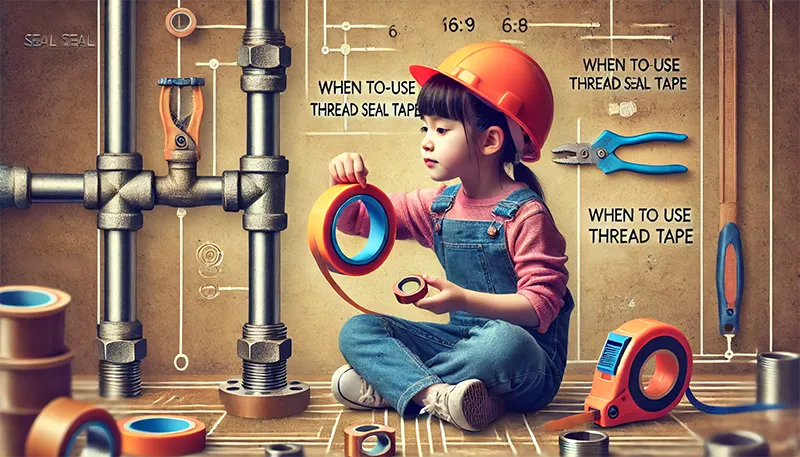Ever struggled with a leaky pipe or a loose connection that just wouldn’t tighten? Thread seal tape, also known as PTFE or Teflon tape, might be the simple solution you’re looking for. This affordable, easy-to-use tool can prevent leaks, secure threaded connections, and make your plumbing tasks a breeze.
In this guide, we’ll explore when to use thread seal tape, how to apply it correctly, and what common mistakes to avoid. Let’s dive in!
What is Thread Seal Tape?
Thread seal tape is a thin, non-sticky film made from polytetrafluoroethylene (PTFE), commonly referred to as Teflon tape. Its primary purpose is to seal threaded pipe connections, ensuring a leak-free and secure fit.
Why It’s Popular:
- Affordable and easy to use.
- Prevents leaks in water, air, and gas systems.
- Reduces friction for smoother tightening of threads.
Thread seal tape is a must-have for DIY enthusiasts and professionals, offering versatility for a wide range of plumbing projects.
When to Use Thread Seal Tape
For Threaded Connections
Thread seal tape is specifically designed for threaded pipes and fittings. It fills the gaps between threads to prevent leaks and create a tight seal.
Examples:
- Showerheads
- Faucets
- Pipe joints
In Low to Moderate Pressure Systems
Thread seal tape works best in systems with low to moderate pressure, such as household plumbing and air lines.
- For higher pressure or industrial systems, additional sealing measures like pipe dope may be needed.
For Water, Gas, and Air Lines
- White PTFE Tape: Use for water and air lines.
- Yellow PTFE Tape: Required for gas lines. It’s thicker and rated for high-pressure gas applications.
- Pink PTFE Tape: Ideal for high-pressure water lines.
On Metal and Plastic Threads
Thread seal tape is compatible with most materials, including metal and plastic. However, avoid overtightening plastic fittings to prevent damage.
For Quick DIY Repairs
Whether you’re fixing a dripping faucet or tightening a shower arm, thread seal tape is a quick and reliable fix for household plumbing problems.
How to Apply Thread Seal Tape
Clean the Threads
Before applying the tape, make sure the threads are clean and free of debris, dirt, or old tape. A clean surface ensures a tighter seal.
Wrap the Tape Clockwise
Always wrap the tape in the same direction as the threading (clockwise). This prevents the tape from unraveling when you tighten the fitting.
Tip: Start wrapping at the base of the threads, overlapping slightly as you go.
Use the Right Number of Wraps
- Small pipes: 2-3 wraps of tape.
- Larger pipes or higher-pressure systems: 4-6 wraps.
Tighten the Connection Gently
After applying the tape, screw the fitting into place and tighten it snugly. Avoid overtightening, especially on plastic threads, to prevent cracking.
Common Mistakes to Avoid
Using the Wrong Tape
- Example: Using white tape on gas lines instead of yellow PTFE tape.
- Always choose the right tape for the specific application.
Applying Too Much or Too Little Tape
- Too much tape can make threading difficult and cause leaks.
- Too little tape won’t seal effectively.
Using on Non-Threaded Connections
Thread seal tape is ineffective on smooth or non-threaded surfaces.
Over-Tightening Plastic Threads
Plastic threads are more delicate than metal ones. Tighten only enough to create a seal without causing damage.
FAQs
-
Can I use thread seal tape on gas lines?
Yes, but only yellow PTFE tape rated for gas applications should be used.
-
Is thread seal tape reusable?
No, thread seal tape should be replaced every time a fitting is undone to ensure a proper seal.
-
What happens if I apply thread seal tape incorrectly?
Incorrect application can lead to leaks, loose fittings, or difficulty tightening the connection.
-
Can thread seal tape stop an existing leak?
No, thread seal tape is a preventive measure. For existing leaks, consider other repair methods like silicone tape or pipe patches.
-
Is thread seal tape safe for drinking water systems?
Yes, but ensure the tape is certified for potable water use. Blue PTFE tape is often recommended for drinking water lines.
Thread seal tape is a simple yet powerful tool for ensuring leak-free threaded connections. From sealing water pipes to securing gas lines, this versatile tape is an essential part of any plumber’s or DIYer’s toolkit.
Always choose the right type of tape for your specific application and follow the correct steps for application. With a little practice, you can tackle plumbing projects with confidence and ease. Keep a roll of thread seal tape handy—you never know when you might need it!



